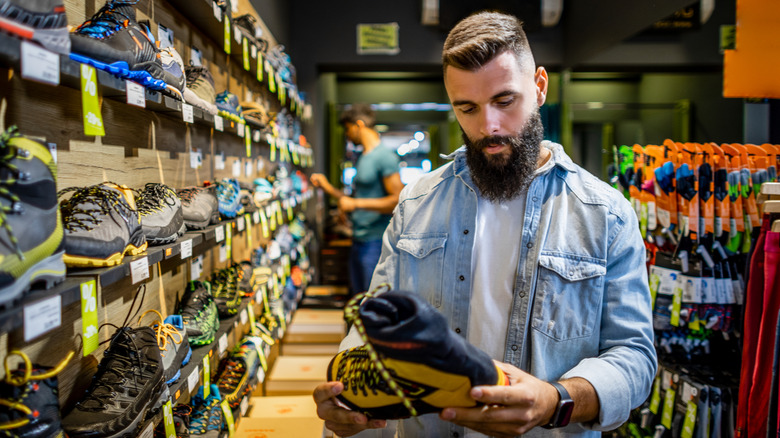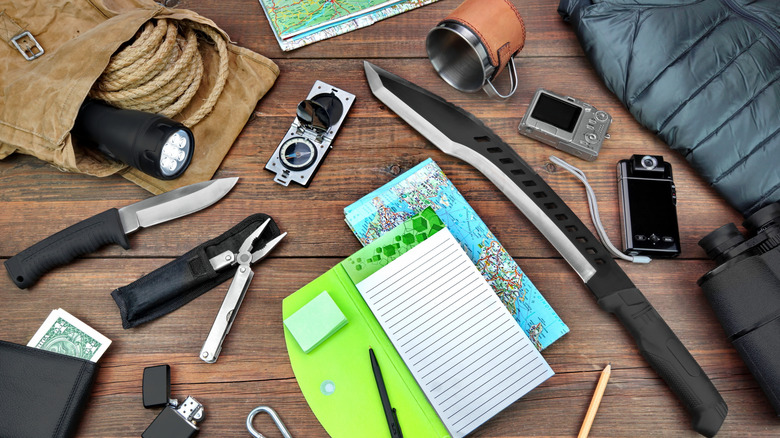Avoid This Costly Mistake When Buying Gear For Your First Hiking Or Backpacking Trip
There's a widespread myth about long hikes: that they're basically free. And it's easy to understand why people think this: Many trail systems, like the Appalachian Trail and Pacific Crest Trail, are wide open and cost nothing to use. Many kinds of public land allow "dispersed camping," as long as you follow certain rules. By definition, you carry just about everything you need on your back, and there aren't a lot of museums or fancy restaurants in the wild. Need some fresh water? Filter some from the river! Change of clothes? Set down your bag and swap some layers! To daydreamers with little experience, a long-distance trek can seem carefree — accent on the "free."
It's true that hiking and camping can be economical pursuits, and they're generally cheaper than, say, trips to Disney World or four-star hotels across Europe. But if you're attempting a multi-day expedition for the first time, you'll probably need to stock up on equipment and provisions, and this will cost money. Indeed, the price tags for quality gear can skyrocket, depending on the outfitter you visit: The coveted Gregory Baltoro 100 backpack costs about $440, and Merrell Moab 3 waterproof hiking boots are $170. Granted, these are top-shelf items, and you'll use these items for years; there's a reason L.L. Bean's corporate slogan is "built to last."
Yet a first-timer will likely need a tent, sleeping bag, bed roll, and cooking set — just to start. Remember, you'll depend entirely on this stuff as you go, so you'll have to choose the right versions of this essential gear. Before you know it, you've spent hundreds or thousands of dollars on bare essentials. This is why budgeting is vital, even for the most grassroots outing.
How to budget for gear (and the trip itself)
First, consider how you'll use this equipment. Will you hike alone, in pairs, or in groups? Do you plan to do a few overnights in a well-trafficked national park, or take on the wilderness? What climates do you expect to pass through? Will you need special equipment, like snow shoes, fishing gear, or bear spray? Are you mostly walking, or will you spend time on the water? "Backpacking" means wildly different things to different people, and the types of trips that interest you will steer your initial investments. For general use, here is a list of best hiking gear on a budget.
It's wise to plan your trip and gear purchases at the same time. Some items can be used for many types of expeditions (tents, boots, trekking poles), but a three-season sleeping bag won't keep you warm in winter, and a sub-zero-rated "mummy bag" will likely roast you in August. Adjusting for seasons can add to expenses, as you double up on gear you thought you already had.
Then there is the trip itself, which will require a lot of short-lived supplies: food, matches, tissue paper, and so on. For truly long hikes — three nights or more — you'll probably have to leave the trail and restock, which will cost time, energy, and yes, money. These are called "bonus miles," and even intermediate hikers often underestimate how much effort they'll put into getting to and from the trailhead. Some routes require long drives or complicated transport just to get started, then additional coordination (and expense) when you've finished and just want to get home. All of these requirements will snowball quickly, making it even more important to plan and budget for them in advance. In short, long hikes can be freeing, but they're not exactly free.

